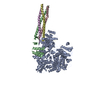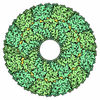[English] 日本語
 Yorodumi
Yorodumi- EMDB-60923: Cryo-EM structure of the full-length Nipah Virus L Protein bound ... -
+ Open data
Open data
- Basic information
Basic information
| Entry |  | |||||||||
|---|---|---|---|---|---|---|---|---|---|---|
| Title | Cryo-EM structure of the full-length Nipah Virus L Protein bound by Phosphoprotein Tetramer | |||||||||
 Map data Map data | ||||||||||
 Sample Sample |
| |||||||||
 Keywords Keywords | RNA polymerase / VIRAL PROTEIN | |||||||||
| Function / homology |  Function and homology information Function and homology informationnegative stranded viral RNA transcription / NNS virus cap methyltransferase / GDP polyribonucleotidyltransferase / negative stranded viral RNA replication / Hydrolases; Acting on acid anhydrides; In phosphorus-containing anhydrides / virion component / molecular adaptor activity / host cell cytoplasm / mRNA 5'-cap (guanine-N7-)-methyltransferase activity / symbiont-mediated suppression of host innate immune response ...negative stranded viral RNA transcription / NNS virus cap methyltransferase / GDP polyribonucleotidyltransferase / negative stranded viral RNA replication / Hydrolases; Acting on acid anhydrides; In phosphorus-containing anhydrides / virion component / molecular adaptor activity / host cell cytoplasm / mRNA 5'-cap (guanine-N7-)-methyltransferase activity / symbiont-mediated suppression of host innate immune response / RNA-directed RNA polymerase / RNA-directed RNA polymerase activity / GTPase activity / ATP binding Similarity search - Function | |||||||||
| Biological species |  Henipavirus nipahense Henipavirus nipahense | |||||||||
| Method | single particle reconstruction / cryo EM / Resolution: 2.52 Å | |||||||||
 Authors Authors | Xue L / Chang T / Gui J / Li Z / Zhao H / Zou B / Li M / He J / Chen X / Xiong X | |||||||||
| Funding support |  China, 1 items China, 1 items
| |||||||||
 Citation Citation |  Journal: Protein Cell / Year: 2025 Journal: Protein Cell / Year: 2025Title: Cryo-EM structures of Nipah virus polymerase complex reveal highly varied interactions between L and P proteins among paramyxoviruses. Authors: Lu Xue / Tiancai Chang / Jiacheng Gui / Zimu Li / Heyu Zhao / Binqian Zou / Junnan Lu / Mei Li / Xin Wen / Shenghua Gao / Peng Zhan / Lijun Rong / Liqiang Feng / Peng Gong / Jun He / Xinwen ...Authors: Lu Xue / Tiancai Chang / Jiacheng Gui / Zimu Li / Heyu Zhao / Binqian Zou / Junnan Lu / Mei Li / Xin Wen / Shenghua Gao / Peng Zhan / Lijun Rong / Liqiang Feng / Peng Gong / Jun He / Xinwen Chen / Xiaoli Xiong /   Abstract: Nipah virus (NiV) and related viruses form a distinct henipavirus genus within the Paramyxoviridae family. NiV continues to spillover into the humans causing deadly outbreaks with increasing human- ...Nipah virus (NiV) and related viruses form a distinct henipavirus genus within the Paramyxoviridae family. NiV continues to spillover into the humans causing deadly outbreaks with increasing human-bat interaction. NiV encodes the large protein (L) and phosphoprotein (P) to form the viral RNA polymerase machinery. Their sequences show limited homologies to those of non-henipavirus paramyxoviruses. We report two cryo-electron microscopy (cryo-EM) structures of the Nipah virus (NiV) polymerase L-P complex, expressed and purified in either its full-length or truncated form. The structures resolve the RNA-dependent RNA polymerase (RdRp) and polyribonucleotidyl transferase (PRNTase) domains of the L protein, as well as a tetrameric P protein bundle bound to the L-RdRp domain. L-protein C-terminal regions are unresolved, indicating flexibility. Two PRNTase domain zinc-binding sites, conserved in most Mononegavirales, are confirmed essential for NiV polymerase activity. The structures further reveal anchoring of the P protein bundle and P protein X domain (XD) linkers on L, via an interaction pattern distinct among Paramyxoviridae. These interactions facilitate binding of a P protein XD linker in the nucleotide entry channel and distinct positioning of other XD linkers. We show that the disruption of the L-P interactions reduces NiV polymerase activity. The reported structures should facilitate rational antiviral-drug discovery and provide a guide for the functional study of NiV polymerase. | |||||||||
| History |
|
- Structure visualization
Structure visualization
| Supplemental images |
|---|
- Downloads & links
Downloads & links
-EMDB archive
| Map data |  emd_60923.map.gz emd_60923.map.gz | 47.2 MB |  EMDB map data format EMDB map data format | |
|---|---|---|---|---|
| Header (meta data) |  emd-60923-v30.xml emd-60923-v30.xml emd-60923.xml emd-60923.xml | 22.5 KB 22.5 KB | Display Display |  EMDB header EMDB header |
| FSC (resolution estimation) |  emd_60923_fsc.xml emd_60923_fsc.xml | 9.5 KB | Display |  FSC data file FSC data file |
| Images |  emd_60923.png emd_60923.png | 45.5 KB | ||
| Masks |  emd_60923_msk_1.map emd_60923_msk_1.map | 91.1 MB |  Mask map Mask map | |
| Filedesc metadata |  emd-60923.cif.gz emd-60923.cif.gz | 7.9 KB | ||
| Others |  emd_60923_half_map_1.map.gz emd_60923_half_map_1.map.gz emd_60923_half_map_2.map.gz emd_60923_half_map_2.map.gz | 84.7 MB 84.7 MB | ||
| Archive directory |  http://ftp.pdbj.org/pub/emdb/structures/EMD-60923 http://ftp.pdbj.org/pub/emdb/structures/EMD-60923 ftp://ftp.pdbj.org/pub/emdb/structures/EMD-60923 ftp://ftp.pdbj.org/pub/emdb/structures/EMD-60923 | HTTPS FTP |
-Validation report
| Summary document |  emd_60923_validation.pdf.gz emd_60923_validation.pdf.gz | 823.7 KB | Display |  EMDB validaton report EMDB validaton report |
|---|---|---|---|---|
| Full document |  emd_60923_full_validation.pdf.gz emd_60923_full_validation.pdf.gz | 823.3 KB | Display | |
| Data in XML |  emd_60923_validation.xml.gz emd_60923_validation.xml.gz | 18.1 KB | Display | |
| Data in CIF |  emd_60923_validation.cif.gz emd_60923_validation.cif.gz | 23.3 KB | Display | |
| Arichive directory |  https://ftp.pdbj.org/pub/emdb/validation_reports/EMD-60923 https://ftp.pdbj.org/pub/emdb/validation_reports/EMD-60923 ftp://ftp.pdbj.org/pub/emdb/validation_reports/EMD-60923 ftp://ftp.pdbj.org/pub/emdb/validation_reports/EMD-60923 | HTTPS FTP |
-Related structure data
| Related structure data |  9ivaMC  9iv9C M: atomic model generated by this map C: citing same article ( |
|---|---|
| Similar structure data | Similarity search - Function & homology  F&H Search F&H Search |
- Links
Links
| EMDB pages |  EMDB (EBI/PDBe) / EMDB (EBI/PDBe) /  EMDataResource EMDataResource |
|---|---|
| Related items in Molecule of the Month |
- Map
Map
| File |  Download / File: emd_60923.map.gz / Format: CCP4 / Size: 91.1 MB / Type: IMAGE STORED AS FLOATING POINT NUMBER (4 BYTES) Download / File: emd_60923.map.gz / Format: CCP4 / Size: 91.1 MB / Type: IMAGE STORED AS FLOATING POINT NUMBER (4 BYTES) | ||||||||||||||||||||||||||||||||||||
|---|---|---|---|---|---|---|---|---|---|---|---|---|---|---|---|---|---|---|---|---|---|---|---|---|---|---|---|---|---|---|---|---|---|---|---|---|---|
| Projections & slices | Image control
Images are generated by Spider. | ||||||||||||||||||||||||||||||||||||
| Voxel size | X=Y=Z: 0.9125 Å | ||||||||||||||||||||||||||||||||||||
| Density |
| ||||||||||||||||||||||||||||||||||||
| Symmetry | Space group: 1 | ||||||||||||||||||||||||||||||||||||
| Details | EMDB XML:
|
-Supplemental data
-Mask #1
| File |  emd_60923_msk_1.map emd_60923_msk_1.map | ||||||||||||
|---|---|---|---|---|---|---|---|---|---|---|---|---|---|
| Projections & Slices |
| ||||||||||||
| Density Histograms |
-Half map: #2
| File | emd_60923_half_map_1.map | ||||||||||||
|---|---|---|---|---|---|---|---|---|---|---|---|---|---|
| Projections & Slices |
| ||||||||||||
| Density Histograms |
-Half map: #1
| File | emd_60923_half_map_2.map | ||||||||||||
|---|---|---|---|---|---|---|---|---|---|---|---|---|---|
| Projections & Slices |
| ||||||||||||
| Density Histograms |
- Sample components
Sample components
-Entire : Cryo-EM structure of the full-length Nipah Virus L Protein bound ...
| Entire | Name: Cryo-EM structure of the full-length Nipah Virus L Protein bound by Phosphoprotein Tetramer |
|---|---|
| Components |
|
-Supramolecule #1: Cryo-EM structure of the full-length Nipah Virus L Protein bound ...
| Supramolecule | Name: Cryo-EM structure of the full-length Nipah Virus L Protein bound by Phosphoprotein Tetramer type: complex / ID: 1 / Parent: 0 / Macromolecule list: #1-#2 |
|---|---|
| Source (natural) | Organism:  Henipavirus nipahense Henipavirus nipahense |
-Macromolecule #1: RNA-directed RNA polymerase L
| Macromolecule | Name: RNA-directed RNA polymerase L / type: protein_or_peptide / ID: 1 / Number of copies: 1 / Enantiomer: LEVO / EC number: RNA-directed RNA polymerase |
|---|---|
| Source (natural) | Organism:  Henipavirus nipahense Henipavirus nipahense |
| Molecular weight | Theoretical: 257.565156 KDa |
| Recombinant expression | Organism:  |
| Sequence | String: MADELSISDI IYPECHLDSP IVSGKLISAI EYAQLRHNQP SDDKRLSENI RLNLHGKRKS LYILRQSKQG DYIRNNIKNL KEFMHIAYP ECNNILFSIT SQGMTSKLDN IMKKSFKAYN IISKKVIGML QNITRNLITQ DRRDEIINIH ECRRLGDLGK N MSQSKWYE ...String: MADELSISDI IYPECHLDSP IVSGKLISAI EYAQLRHNQP SDDKRLSENI RLNLHGKRKS LYILRQSKQG DYIRNNIKNL KEFMHIAYP ECNNILFSIT SQGMTSKLDN IMKKSFKAYN IISKKVIGML QNITRNLITQ DRRDEIINIH ECRRLGDLGK N MSQSKWYE CFLFWFTIKT EMRAVIKNSQ KPKFRSDSCI IHMRDKSTEI ILNPNLICIF KSDKTGKKCY YLTPEMVLMY CD VLEGRMM METTVKSDIK YQPLISRSNA LWGLIDPLFP VMGNRIYNIV SMIEPLVLAL LQLKDEARIL RGAFLHHCIK EMH QELSEC GFTDQKIRSM FIDDLLSILN IDNIHLLAEF FSFFRTFGHP ILEAKVAAEK VREHMLADKV LEYAPIMKAH AIFC GTIIN GYRDRHGGAW PPLYLPAHAS KHIIRLKNSG ESLTIDDCVK NWESFCGIQF DCFMELKLDS DLSMYMKDKA LSPIK DEWD SVYPREVLSY TPPKSTEPRR LVDVFVNDEN FDPYNMLEYV LSGAYLEDEQ FNVSYSLKEK ETKQAGRLFA KMTYKM RAC QVIAEALIAS GVGKYFKENG MVKDEHELLK TLFQLSISSV PRGNSQGNDP QSINNIERDF QYFKGVTTNV KDKKNNS FN KVKSALNNPC QADGVHHNMS PNTRNRYKCS NTSKSFLDYH TEFNPHNHYK SDNTEAAVLS RYEDNTGTKF DTVSAFLT T DLKKFCLNWR YESMAIFAER LDEIYGLPGF FNWMHKRLER SVIYVADPNC PPNIDKHMEL EKTPEDDIFI HYPKGGIEG YSQKTWTIAT IPFLFLSAYE TNTRIAAIVQ GDNESIAITQ KVHPNLPYKV KKEICAKQAQ LYFERLRMNL RALGHNLKAT ETIISTHLF IYSKKIHYDG AVLSQALKSM SRCCFWSETL VDETRSACSN ISTTIAKAIE NGLSRNVGYC INILKVIQQL L ISTEFSIN ETLTLDVTSP ISNNLDWLIT AALIPAPIGG FNYLNLSRIF VRNIGDPVTA SLADLKRMID HSIMTESVLQ KV MNQEPGD ASFLDWASDP YSGNLPDSQS ITKTIKNITA RTILRNSPNP MLKGLFHDKS FDEDLELASF LMDRRVILPR AAH EILDNS LTGAREEIAG LLDTTKGLIR SGLRKSGLQP KLVSRLSHHD YNQFLILNKL LSNRRQNDLI SSNTCSVDLA RALR SHMWR ELALGRVIYG LEVPDALEAM VGRYITGSLE CQICEQGNTM YGWFFVPRDS QLDQVDREHS SIRVPYVGSS TDERS DIKL GNVKRPTKAL RSAIRIATVY TWAYGDNEEC WYEAWYLASQ RVNIDLDVLK AITPVSTSNN LSHRLRDKST QFKFAG SVL NRVSRYVNIS NDNLDFRIEG EKVDTNLIYQ QAMLLGLSVL EGKFRLRLET DDYNGIYHLH VKDNCCVKEV ADVGQVD AE LPIPEYTEVD NNHLIYDPDP VSEIDCSRLS NQESKSRELD FPLWSTEELH DVLAKTVAQT VLEIITKADK DVLKQHLA I DSDDNINSLI TEFLIVDPEL FALYLGQSIS IKWAFEIHHR RPRGRHTMVD LLSDLVSNTS KHTYKVLSNA LSHPRVFKR FVNCGLLLPT QGPYLHQQDF EKLSQNLLVT SYMIYLMNWC DFKKSPFLIA EQDETVISLR EDIITSKHLC VIIDLYANHH KPPWIIDLN PQEKICVLRD FISKSRHVDT SSRSWNTSDL DFVIFYASLT YLRRGIIKQL RIRQVTEVID TTTMLRDNII V ENPPIKTG VLDIRGCIIY NLEEILSMNT KSASKKIFNL NSRPSVENHK YRRIGLNSSS CYKALNLSPL IQRYLPSGAQ RL FIGEGSG SMMLLYQSTL GQSISFYNSG IDGDYIPGQR ELKLFPSEYS IAEEDPSLTG KLKGLVVPLF NGRPETTWIG NLD SYEYII NRTAGRSIGL VHSDMESGID KNVEEILVEH SHLISIAINV MMEDGLLVSK IAYTPGFPIS RLFNMYRSYF GLVL VCFPV YSNPDSTEVY LLCLQKTVKT IVPPQKVLEH SNLHDEVNDQ GITSVIFKIK NSQSKQFHDD LKKYYQIDQP FFVPT KITS DEQVLLQAGL KLNGPEILKS EISYDIGSDI NTLRDTIIIM LNEAMNYFDD NRSPSHHLEP YPVLERTRIK TIMNCV TKK VIVYSLIKFK DTKSSELYHI KNNIRRKVLI LDFRSKLMTK TLPKGMQERR EKNGFKEVWI VDLSNREVKI WWKIIGY IS II UniProtKB: RNA-directed RNA polymerase L |
-Macromolecule #2: Phosphoprotein
| Macromolecule | Name: Phosphoprotein / type: protein_or_peptide / ID: 2 / Number of copies: 4 / Enantiomer: LEVO |
|---|---|
| Source (natural) | Organism:  Henipavirus nipahense Henipavirus nipahense |
| Molecular weight | Theoretical: 78.39032 KDa |
| Recombinant expression | Organism:  |
| Sequence | String: MDKLELVNDG LNIIDFIQKN QKEIQKTYGR SSIQQPSIKD QTKAWEDFLQ CTSGESEQVE GGMSKDDGDV ERRNLEDLSS TSPTDGTIG KRVSNTRDWA EGSDDIQLDP VVTDVVYHDH GGECTGYGFT SSPERGWSDY TSGANNGNVC LVSDAKMLSY A PEIAVSKE ...String: MDKLELVNDG LNIIDFIQKN QKEIQKTYGR SSIQQPSIKD QTKAWEDFLQ CTSGESEQVE GGMSKDDGDV ERRNLEDLSS TSPTDGTIG KRVSNTRDWA EGSDDIQLDP VVTDVVYHDH GGECTGYGFT SSPERGWSDY TSGANNGNVC LVSDAKMLSY A PEIAVSKE DRETDLVHLE NKLSTTGLNP TAVPFTLRNL SDPAKDSPVI AEHYYGLGVK EQNVGPQTSR NVNLDSIKLY TS DDEEADQ LEFEDEFAGS SSEVIVGISP EDEEPSSVGG KPNESIGRTI EGQSIRDNLQ AKDNKSTDVP GAGPKDSAVK EEP PQKRLP MLAEEFECSG SEDPIIRELL KENSLINCQQ GKDAQPPYHW SIERSISPDK TEIVNGAVQT ADRQRPGTPM PKSR GIPIK KGTDAKYPSA GTENVPGSKS GATRHVRGSP PYQEGKSVNA ENVQLNASTA VKETDKSEVN PVDDNDSLDD KYIMP SDDF SNTFFPHDTD RLNYHADHLG DYDLETLCEE SVLMGVINSI KLINLDMRLN HIEEQVKEIP KIINKLESID RVLAKT NTA LSTIEGHLVS MMIMIPGKGK GERKGKNNPE LKPVIGRDIL EQQSLFSFDN VKNFRDGSLT NEPYGAAVQL REDLILP EL NFEETNASQF VPMADDSSRD VIKTLIRTHI KDRELRSELI GYLNKAENDE EIQEIANTVN DIIDGNI UniProtKB: Phosphoprotein |
-Macromolecule #3: ZINC ION
| Macromolecule | Name: ZINC ION / type: ligand / ID: 3 / Number of copies: 2 / Formula: ZN |
|---|---|
| Molecular weight | Theoretical: 65.409 Da |
-Experimental details
-Structure determination
| Method | cryo EM |
|---|---|
 Processing Processing | single particle reconstruction |
| Aggregation state | particle |
- Sample preparation
Sample preparation
| Buffer | pH: 8 |
|---|---|
| Vitrification | Cryogen name: ETHANE |
- Electron microscopy
Electron microscopy
| Microscope | TFS KRIOS |
|---|---|
| Image recording | Film or detector model: TFS FALCON 4i (4k x 4k) / Average electron dose: 50.0 e/Å2 |
| Electron beam | Acceleration voltage: 300 kV / Electron source:  FIELD EMISSION GUN FIELD EMISSION GUN |
| Electron optics | Illumination mode: FLOOD BEAM / Imaging mode: BRIGHT FIELD / Nominal defocus max: 2.4 µm / Nominal defocus min: 0.6 µm |
| Experimental equipment |  Model: Titan Krios / Image courtesy: FEI Company |
 Movie
Movie Controller
Controller







 Z (Sec.)
Z (Sec.) Y (Row.)
Y (Row.) X (Col.)
X (Col.)













































